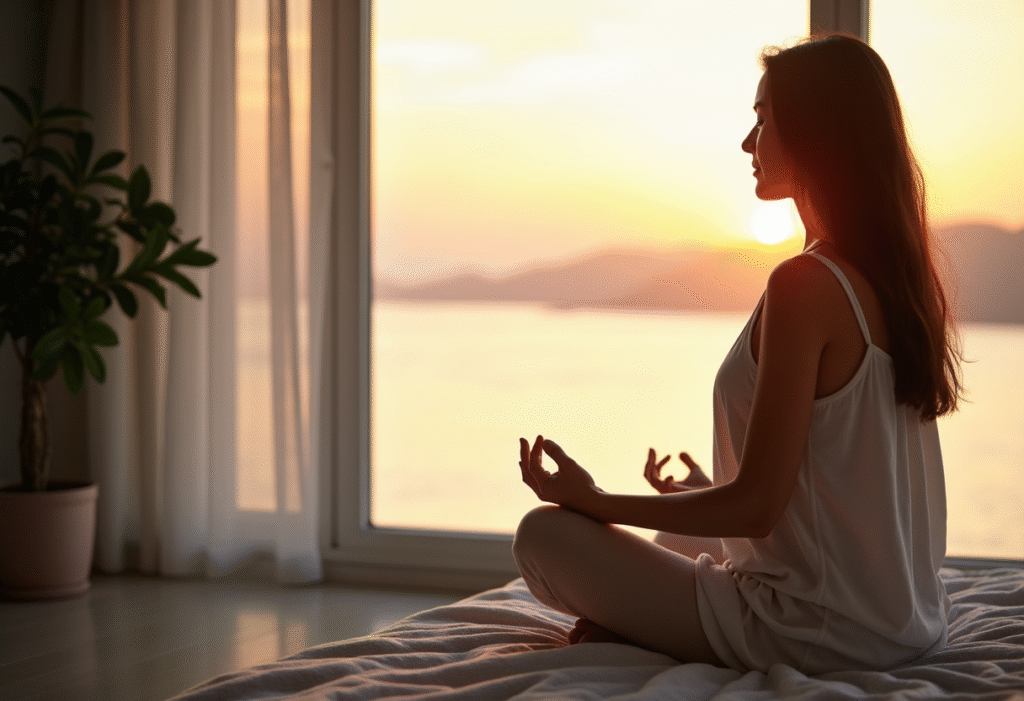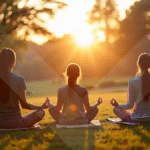In our fast-paced world, anxiety has become a common challenge, affecting millions and impacting daily life. While stress is a natural part of existence, chronic anxiety can disrupt your well-being, productivity, and overall happiness. The good news is that you don’t have to live under its constant shadow. There are powerful, accessible ways to regain control and find your calm.
This comprehensive guide will explore various effective relaxation techniques for anxiety that you can integrate into your routine. From simple breathing exercises to profound mindfulness practices, we’ll equip you with the knowledge and tools to manage anxious feelings, reduce stress, and cultivate a deeper sense of inner peace. Prepare to discover practical strategies that empower you to navigate life’s challenges with greater ease and resilience.
Why Practicing Relaxation Techniques for Anxiety Matters
Anxiety is more than just a feeling; it’s a complex response involving your mind and body. When you experience anxiety, your body often shifts into a “fight or flight” mode, releasing stress hormones like cortisol and adrenaline. This can lead to physical symptoms such as a racing heart, shallow breathing, muscle tension, digestive issues, and disrupted sleep. Mentally, anxiety can manifest as constant worry, difficulty concentrating, irritability, and a feeling of being overwhelmed.
Regularly engaging in relaxation techniques for anxiety actively counters this stress response. It signals to your nervous system that you are safe, allowing your body to switch to the “rest and digest” mode. This shift brings a cascade of benefits, including lowered heart rate and blood pressure, relaxed muscles, improved digestion, and a strengthened immune system. Beyond the physical, these techniques foster mental clarity, enhance mood, boost emotional regulation, and improve your ability to cope with daily stressors. Learning to calm your body and mind is not a luxury; it’s a fundamental aspect of maintaining holistic health and building resilience against the pressures of modern life.
Top Recommended Products for Anxiety & Stress Support
While mastering relaxation techniques is a powerful tool, certain natural supplements and programs can offer complementary support to enhance your journey towards calm and well-being. These carefully selected products align with the goal of reducing stress, improving sleep, and fostering mental clarity, making them excellent additions to your anxiety management strategy.
- Magnesium Breakthrough: Magnesium is a vital mineral involved in over 300 bodily functions, including nerve and muscle function, and energy production. It’s often called the “relaxation mineral” because it plays a crucial role in calming the nervous system and promoting better sleep. For individuals struggling with anxiety, Magnesium Breakthrough can help support your body’s natural relaxation response, ease muscle tension, and improve sleep quality, which is often compromised by anxious states. Ensuring adequate magnesium intake can be a foundational step in managing stress and fostering a sense of calm.
- Back to Life: Physical tension is a common companion to anxiety. The Back to Life program offers gentle movements, stretches, and stress management techniques designed to alleviate physical discomfort and promote relaxation. By focusing on core strength, flexibility, and proper posture, this program can help release stored tension in the body, which often contributes to feelings of unease. Incorporating these gentle physical practices provides a holistic approach to calming both the body and mind, making it easier to engage in deeper relaxation and mindfulness.
- Cortexi: In moments of anxiety, the mind can feel chaotic and scattered, making it difficult to focus or achieve mental stillness. Cortexi is formulated to support cognitive function and promote mental clarity. By enhancing focus and reducing mental fog, it can be an invaluable aid when practicing mindfulness meditation or other concentration-based relaxation techniques. A clearer, more focused mind can better engage with present-moment awareness, allowing you to observe anxious thoughts without getting swept away by them, thereby strengthening your ability to manage anxiety effectively.

Actionable Tips for Success with Relaxation Techniques
Implementing relaxation techniques effectively requires consistency and patience. Here are practical, actionable tips to help you integrate these strategies into your daily life and achieve lasting calm:
- Practice Diaphragmatic Breathing (Belly Breathing): This is one of the simplest yet most powerful relaxation techniques for anxiety. Sit or lie comfortably. Place one hand on your chest and the other on your abdomen. Inhale slowly and deeply through your nose, feeling your abdomen rise while your chest remains relatively still. Exhale slowly through pursed lips, allowing your abdomen to fall. Aim for 5-10 minutes, several times a day. This technique activates the parasympathetic nervous system, promoting immediate calm.
- Engage in Progressive Muscle Relaxation (PMR): PMR involves tensing and then relaxing different muscle groups throughout your body. Start with your feet, tense them for 5-10 seconds, then release completely, noticing the difference. Move up your body to your legs, buttocks, abdomen, arms, hands, shoulders, neck, and face. This practice helps you become more aware of physical tension and teaches your body how to relax deeply.
- Cultivate Mindfulness Meditation: Mindfulness is about focusing on the present moment without judgment. You can practice by sitting quietly and paying attention to your breath, sounds, or bodily sensations as they arise. When your mind wanders (which it will), gently bring your attention back. Even 5-10 minutes daily can significantly reduce anxious thoughts and improve emotional regulation.
- Incorporate Gentle Movement: Activities like yoga, Tai Chi, or even a brisk walk can be excellent relaxation techniques. They combine physical movement with breath awareness, helping to release physical tension and clear your mind. Regular physical activity naturally reduces stress hormones and boosts mood-enhancing neurotransmitters.
- Spend Time in Nature: Research consistently shows that spending time outdoors can significantly reduce stress and anxiety. Whether it’s a walk in a park, sitting by a lake, or simply tending to a garden, connecting with nature has a profound calming effect. Focus on the sights, sounds, and smells around you to enhance the experience.
- Journal Your Thoughts: Writing down your worries and feelings can be a therapeutic way to process anxiety. It helps externalize your concerns, making them feel less overwhelming and providing clarity. Don’t worry about grammar or spelling; just let your thoughts flow freely onto the page. This practice can reveal patterns and offer insights into your anxiety triggers.
The key to success is finding the techniques that resonate most with you and committing to a consistent practice. Start small, be patient with yourself, and observe the positive shifts in your mental and emotional well-being.
Common Mistakes to Avoid When Practicing Relaxation Techniques
While the path to managing anxiety through relaxation is rewarding, it’s easy to fall into common traps that can hinder your progress. Being aware of these pitfalls can help you navigate your journey more effectively:
- Expecting Instant Results: Relaxation is a skill that develops over time, not a magic bullet. Don’t get discouraged if you don’t feel completely calm after your first attempt. Consistency is far more important than intensity.
- Inconsistency in Practice: Skipping days or only practicing when anxiety is at its peak diminishes effectiveness. Regular, even short, daily practice builds resilience and makes it easier to tap into calm when you need it most.
- Ignoring Professional Help: Relaxation techniques are powerful tools, but they are not a substitute for professional medical or psychological help, especially for severe or chronic anxiety. Consider them complementary to therapy or medical advice.
- Overcomplicating Techniques: Many relaxation techniques are simple by design. Don’t feel pressured to master complex meditation styles immediately. Start with basic breathing or body scans, and build up gradually.
- Comparing Your Progress: Everyone’s journey with anxiety and relaxation is unique. Avoid comparing your experience to others you see online or hear about. Focus on your own progress and celebrate small victories.
- Using Relaxation as Avoidance: While relaxation provides relief, it shouldn’t be used to avoid addressing the underlying causes of your anxiety. It’s a tool for managing symptoms, allowing you to confront issues more effectively, not to escape them.
Conclusion & Call to Action
Navigating the challenges of anxiety can feel overwhelming, but the power to cultivate inner peace lies within your grasp. By consistently incorporating effective relaxation techniques for anxiety into your daily routine, you can significantly reduce stress, calm your nervous system, and foster a greater sense of well-being. Remember, this journey is about progress, not perfection. Each breath, each mindful moment, and each conscious effort contributes to a more resilient and peaceful you.
Don’t wait for anxiety to dictate your life. Start today by choosing one or two techniques that resonate with you and commit to practicing them regularly. Explore complementary support options like Magnesium Breakthrough for nerve support, the Back to Life program for physical release, or Cortexi for mental clarity. Take that first step towards a calmer, more balanced life. Your journey to inner peace begins now!

FAQs About Relaxation Techniques for Anxiety
Q1: How quickly can I expect relaxation techniques for anxiety to work?
A: The effects can vary greatly from person to person. Some people experience immediate relief from a single breathing exercise or short meditation, feeling a noticeable shift in their body and mind. However, for deeper, more lasting changes in managing chronic anxiety, consistent practice over weeks or months is typically required. Think of it like building a muscle – regular exercise yields stronger, more sustained results.
Q2: Can I combine different relaxation techniques for anxiety, or should I stick to one?
A: Absolutely! Combining different relaxation techniques can be highly effective and is often encouraged. For example, you might start your day with mindfulness meditation, take a few deep breaths before a stressful meeting, and practice progressive muscle relaxation before bed. Experiment with various techniques to discover what works best for you and integrate them into different parts of your day to create a personalized anxiety management toolkit.



